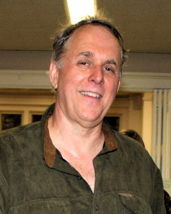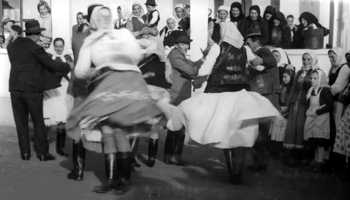
|
Folk Dance Federation of California, South, Inc.
|

|
CLICK IMAGE TO ENLARGE
Between the rivers Someșul Mic (Hungarian: Kis Szamos) and Mureșul (Hungarian: Maros), northeast and east of the Transylvanian city of Cluj-Napoca (Hungarian: Kolozsvár), lies the ethnographic region known to Hungarian-speaking peoples as the Mezöség (mezö = "field or farmland). Although situated within Romania's political boundaries, there is a large Hungarian-speaking population living both in strictly Hungarian-speaking villages as well as in villages of mixed populations (Hungarian, Romanian, and Gypsy).
When speaking about the Mezöségi Táncok (dances from Mezöség), I am referring to a set of dances of a "dance cycle" which has become popular in the "Táncház" (dance house) movement in Hungary and among Hungarian-speaking youth in Erdély, Transylvania. This particular cycle is based on the songs and dance forms originally performed in Mezöség villages such as Magyarpalatka, Mezökeszü, Vajdakamarás, and others. The dance cycle, as it is done in the Táncház was originally introduced by Sándor Timár. Research and publications about Mezöség dance have also been written by Zoltán Kallós and György Martin, to mention two.
The Dance Cycle
 The dance cycle, as it is popular in the Táncház, is made up of four dances: "Akasztós," "Ritka csárdás," "Szökös," and Sürü csárdás." The Ritka csárdás, Szökös, and Sürü csárdás are structurally the same but different in style, tempo, and melody.
The dance cycle, as it is popular in the Táncház, is made up of four dances: "Akasztós," "Ritka csárdás," "Szökös," and Sürü csárdás." The Ritka csárdás, Szökös, and Sürü csárdás are structurally the same but different in style, tempo, and melody.
Martin and Kallós mention the "Ritka magyar," a men's solo "verbunk" or "legényes" type dance, that precedes the "Akasztós" but seems to be dying out, as is the case with other men's dances in the Mezöség region. Another popular form is the so-called "Szaszka," or Saxon dance, performed in groups of three, usually one man and two women, but not unknown with three women. This form utilizes the same steps and forms as the above-mentioned Csárdás, Ritka, Szökös, and Sürü.
These dances belong to the general Transylvanian "whirling" or turning dance family, the closest relatives being the Romanian "Învîrtita," "Haţegana," "Harţag," "Măunţelu," "Bătuta," "Ardeleana," and "De-a Lungul."
"Akasztós" is characterized by its very slow asymmetrical rhythm. In both the music and the dance there is a definite lengthening of the second beat, giving a limping or dragging feeling to the dance. Not unlike the "Pajduško" or "Rustemul," the dance has a quick-slow musical beat, often in 5/8 or 6/8 time. The dance begins with couples singing opposite the band. Gradually, they begin to dance, continuing to sing, with slow walking turning steps, occasionally accelerating the turn with a "dragging-limping" step. The content of the songs for the Akasztós deal generally with the frustrations of love.
As the music speeds up and the beat becomes more regular, a transition into the following "csárdás" forms occur. This transition is a simple walking "rida" couple turn in either direction, starting with the outside foot, evolving eventually into the "Ritka csárdás" (slow csárdás). As mentioned previously, the Ritka, Szökös, and Sürü csárdás are structurally the same. They differ in tempo (Ritka = "slow:" Sürü = fast) and style (Szökös = "jumping") and melodies or songs. These dances, although strict in form within the given regional vocabulary, allow for many variations, both individual and couple, including whirling, stamping, boot-slapping, and jumping.
It is important to note, however, that this improvisation has a basic set of rules for construction based on signals from the man to his partner. During these dances, the singing continues, and as the music speeds up, witty dance calls or rhymes ("csujogatás" or "ujjogtatás") are interjected spontaneously.
Occasions for Dance
The tradition of "Táncház" (dance house) or "Tánc" (dance) in Mezöség was very common and popular in many villages until quite recently. This use of the word Táncház should not be confused with the "Táncház" movement in Hungary, although the Hungarian "Táncház" movement was, to some extent, modeled on the Széki "Táncház."
In Mezöség, young unmarried men would rent a house and convert it into a small dance hall. The walls would be lined with benches and the musicians would be provided with a small, raised stage. The musicians, usually Gypsies, played as often as three times a week for their "get-togethers." The young unmarried women would take turns preparing meals for the musicians, and the young men chipped in enough money or favors to pay them.
The Táncház became the central meeting place and constituted much of the social life for the young unmarried adults. To attend Táncház meant a degree of acceptance and maturity within the community. Therefore, the Táncház was the most important stage for social and economic interaction as well as for choosing a mate.
There were as many as three dance houses in some Mezöség villages. This basic social structure existed throughout Mezöség and also among other Hungarian-speaking populations in Romania.
Although the Táncház was restricted to unmarried young adults, on other occasions, such as weddings, religious holidays, sewing bees, work parties, et cetera, dancing for the whole community, young and old, took place. Dances also were held outdoors, in barns, or even in large tents erected solely for this purpose.
The musicians for the dancing were mostly Gypsies living in the village. A typical orchestra consisted of three musicians: a "prímás" playing "hegedü" (violin), a "kontra" (viola), and a "bögö (double bass).
During the dance, each couple tries to get to the space in front of the musicians for a short solo to "show their stuff." They then move off to let the next couple have their turn.
Used with permission of the author.
Reprinted from the 1981 University of the Pacific (Stockton) Folk Dance Camp syllabus.